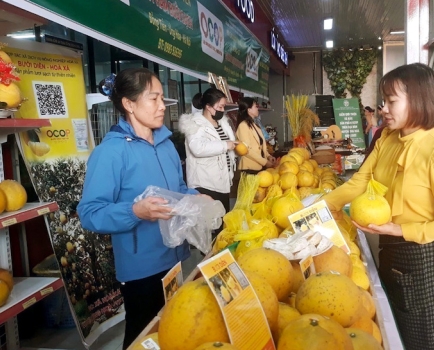Dynamic, Creative and Connected New Rural Areas
Tue, 07 Jan 2025 14:37:00 | Print | Email Share:
Over the years, the nationwide movement to develop new-style rural areas has transitioned from prioritizing quantity to emphasizing quality. Localities are now not only working to meet new rural area standards but are also focusing on enhancing the quality of achieved criteria, particularly in critical areas such as the environment, education and healthcare. This ensures the sustainability of past achievements while laying a strong foundation for building exemplary rural communities. Vietnam Business Forum interviewed Mr. Phuong Dinh Anh, Deputy Chief of the Central Coordination Office for New Rural Area Development, the Ministry of Agriculture and Rural Development (MARD), on this issue.
Could you share the results of the National Targeted Programs for New Rural Development for the 2021-2025 period?
By the end of 2024, it is expected that approximately 79 -79.5% of communes nationwide will achieve recognition for meeting new rural standards. Among these, around 38% are expected to meet advanced standards, while 10% will attain model standards. At the district level, about 305 units (47%) are expected to be recognized for meeting or fulfilling the criteria for new-style rural development, with approximately 18 districts (5.9%) achieving advanced standards. However, no district has yet reached model standards. Additionally, one or two provinces or centrally-governed cities are expected to be recognized by the Prime Minister as having completed the task of building new-style rural areas, reaching approximately 53% of the target set for 2025.

To achieve the good outcomes, provinces and cities have formulated comprehensive plans to implement the National Targeted Programs for New Rural Development in 2024. The plans focus on enhancing the quality of new rural criteria, prioritizing rural economic growth, improving infrastructure, promoting cultural and social activities, and expanding the application of information technology. Localities have intensified efforts to enhance key criteria, particularly in essential areas such as transportation infrastructure, education, healthcare, and environmental sanitation. They are advancing the development of exemplary new rural areas, selecting model communes that exemplify innovation and sustainability. These model areas focus on stricter standards, including the integration of renewable energy, the promotion of sustainable craft villages, and the growth of rural tourism. By elevating the quality of these criteria, the initiative not only reinforces past achievements but also drives strong development, equipping localities to address the evolving needs of their communities and adapt to new challenges in the current period.

The nationwide movement to develop new-style rural areas has shifted its focus from quantity to quality
The OCOP program is considered a solid foundation in the process of building new rural areas. What are the highlights of the program?
After more than five years of implementing the One Commune One Product (OCOP) program, OCOP products have increasingly tapped into and showcased the cultural and traditional values of localities. Each OCOP product acts as an "ambassador" for its region, narrating compelling production stories imbued with human values. Over time, these products have steadily established their value and quality in the market, earning the trust and confidence of consumers.
As of now, Vietnam boasts 14,208 OCOP products rated 3 stars or higher, with 72.3% classified as 3-star products, 25.6% as 4-star products, and 2.1% as 5-star or potential 5-star products. There are 7,894 OCOP entities nationwide, comprising 32.9% cooperatives, 23.2% small businesses, 38.2% production facilities, and the remainder as other types of cooperatives. Developing OCOP products has contributed to increasing value, helping entities expand production scale and revenue. The rate of OCOP entities increasing production volume after being recognized as OCOP is 46.0%, with average sales revenue increasing by 29.7%; the rate of OCOP products with increased selling prices is 50.43%, with an average price increase of 17.5%.
Notably, the program has created significant changes in commerce, with OCOP products being stably distributed in supermarket systems, widely promoted and consumed through online sales (interactive) on social networks, especially TikTok. As a result, many OCOP products have reached international markets.

Efforts are ongoing to build exemplary rural communities
With growing demand for OCOP products domestically and internationally, what steps should be taken to strengthen the brand and drive future development?
In reality, OCOP products meet food safety standards and technical standards of Vietnam, such as ISO, HACCP, GAP, and some products, especially 5-star and potential 5-star OCOP products, also meet international market standards.
OCOP products are distinctive specialties, each telling its own "story" and embodying the unique cultural values of the locality, region or area they represent. This is a special strength of OCOP products compared to mass-produced industrial products. Additionally, since the production volume of each OCOP product is limited, if it has established a market position and is accepted by the market, demand will always exceed supply, especially as socio-economic life improves.
Recent surveys reveal strong international demand for OCOP products, especially among overseas Vietnamese in Europe and the U.S.
However, for OCOP products, it is necessary to focus on organizing production to meet quality requirements, technical barriers and especially the perspective of participating in the market responsibly, transparently and sustainably.
Additionally, many localities, including Hanoi, Quang Ninh, Lang Son, Thanh Hoa and others, have been boosting product consumption through cultural and tourism activities. By combining with tourism, localities have promoted production and procurement activities, forming a modern and sustainable supply and consumption chain. This has encouraged localities to actively participate in producing strong products and developing the economy.
The OCOP program has successfully spotlighted the unique specialty agricultural products of each locality. From this program, trade promotion and product promotion activities for OCOP products have been actively promoted by departments, sectors, and localities, exploiting the potential and strengths of each locality. Building a brand for OCOP products is one of the top solutions for local agricultural products to continue to stand firm in domestic markets and aim for export. Recognizing this important role, many localities have focused on developing raw material areas that are local advantages, promoting linkages to build production chains, opening up opportunities for sustainable agricultural and rural economic development.
Thank you very much!
By: Minh Ngoc, Vietnam Business Forum
Source: https://vccinews.com/news/59901/dynamic-creative-and-connected-new-rural-areas.html
---------------------------------------------
Same category News :













